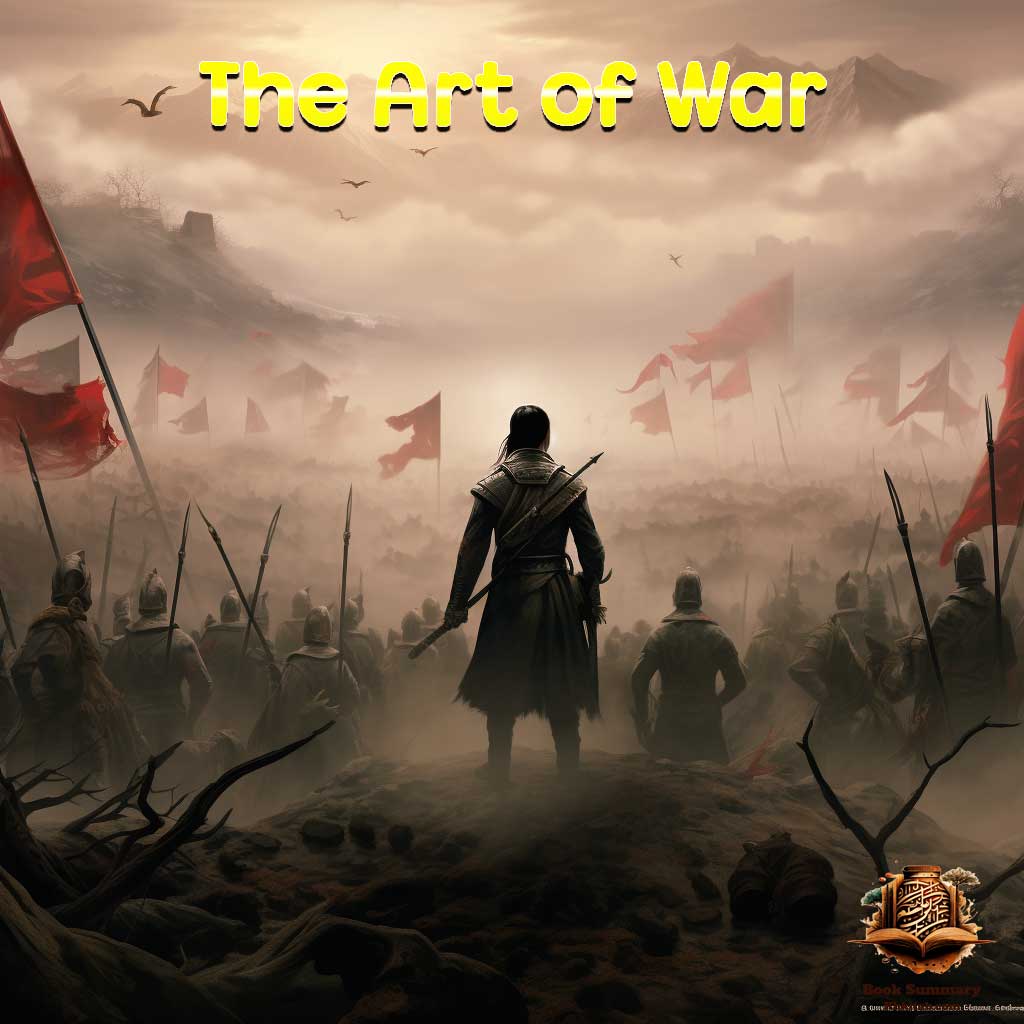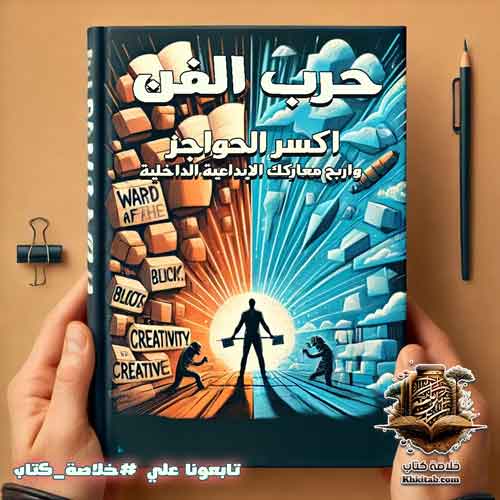The Art of War Book Summary

“The Art of War” is one of the oldest and most renowned treatises on military strategy in history. Attributed to Sun Tzu, an ancient Chinese strategist and philosopher who lived in the 6th century BCE, the book’s timeless wisdom continues to inspire and guide leaders and strategists to this day.
The power of “The Art of War” lies not only in its military advice but in its comprehensive exploration of leadership, tactics, and strategy. As such, its application isn’t limited to warfare alone; it’s revered and employed across various fields, including business and politics.
The book elucidates Sun Tzu’s profound understanding of conflict management, navigating complex scenarios, and discerning an adversary’s strengths and weaknesses. It places significant emphasis on the roles of deception and surprise in achieving victory.
More than a mere military manual, “The Art of War” is a life philosophy. It instructs on confronting challenges and overcoming adversarial situations. Despite the centuries that have passed since its composition, its teachings remain relevant, applied, and studied worldwide.
إقرأ أيضا:The Rules of Parenting: Charting the Path to a Joyful and United FamilyTable of Contents
Why is Planning and Strategic Thinking Essential in “The Art of War”?
Sun Tzu’s “The Art of War” emphasizes the significance of planning and long-term strategic thinking as foundational principles in any endeavor, particularly warfare. In today’s competitive digital age, where businesses and leaders vie for dominance in their respective fields, these principles from an ancient text are more relevant than ever.
Planning, as elaborated in “The Art of War,” isn’t a mere checklist of things to be done. It’s a comprehensive understanding of the situation, including knowing one’s own strengths and weaknesses as well as those of the adversary. Sun Tzu believed that by comprehensively planning, one can foresee potential outcomes and be better prepared for any eventuality. He famously stated, “All battles are won before they are fought.” This underscores the belief that meticulous planning can secure victory even before the battle commences.
Furthermore, long-term strategic thinking is not about reacting to immediate challenges but about anticipating them. It’s about having a vision for the future and aligning present actions with that vision. The essence of Sun Tzu’s teaching in this context is the ability to be patient, wait for the opportune moment, and then strike with full force. It is the idea of conserving energy, gathering information, and positioning oneself in the best possible manner.
Drawing parallels to the modern world, businesses can derive immense value from Sun Tzu’s emphasis on planning and strategy. Whether launching a new product, entering a new market, or combating competition, the principles of assessing the environment, understanding the competition, and devising a robust plan remain critical. The longevity and success of a business or campaign don’t solely depend on resources but largely on how effectively those resources are managed and deployed.
In conclusion, Sun Tzu’s “The Art of War” offers timeless insights into planning and strategic thinking. These concepts, though rooted in ancient warfare, find relevance in various facets of modern-day life, from business to personal endeavors, making the treatise a must-read for those aspiring to excel in their fields.
Our Page in Face book – Book Summary
How Does “The Art of War” Address the Economic Implications of Warfare and the Urgency of Swift Action?
In Sun Tzu’s legendary manual, “The Art of War,” the aspect of waging war is not solely viewed from a military perspective, but also from an economic one. The book delves deep into understanding the costs associated with going to war and the critical nature of acting with decisiveness.
Sun Tzu strongly believed that prolonged warfare negatively impacts a nation’s resources. Engaging in lengthy battles drains the coffers, depletes manpower, and disrupts the normalcy of a country’s socioeconomic structures. The extended strain on resources without achieving decisive results could lead to both economic and morale collapse. As a result, Sun Tzu emphasized the importance of calculated and swift military campaigns to minimize these negative economic implications. A well-executed quick strike can lead to victory, conserve resources, and limit the economic strain on a nation.
Moreover, “The Art of War” underlines the necessity of swift action, not just to save resources but also to catch the enemy off-guard. In a landscape of uncertainty, the element of surprise is an invaluable advantage. By moving quickly and decisively, a military force can capitalize on the enemy’s unpreparedness, leading to quicker resolutions and reducing the overall impact on a nation’s economy.
In contemporary contexts, the teachings of Sun Tzu in “The Art of War” hold relevance beyond the battlefield. Today’s businesses and leaders can draw parallels between the costs of drawn-out competitive battles in the market and the necessity for quick, decisive actions to gain a competitive edge and maximize resource efficiency.
In essence, Sun Tzu’s exploration of waging war is a masterclass in understanding the balance between patience and action. It serves as a guide, teaching us that while it’s essential to act decisively, it’s equally crucial to understand the broader economic implications of those actions, ensuring that victories are not just immediate but sustainable in the long run.
Politics books – Book Summary (khkitab.com)
How Does “The Art of War” Elucidate Strategies for Taking Initiative and Striking the Enemy?
Sun Tzu’s seminal work, “The Art of War,” is a treasure trove of wisdom that emphasizes not only defensive tactics but also strategies for taking the offensive. A proactive approach to warfare, according to Sun Tzu, can often be the key to turning the tide of battle in one’s favor.
In the realm of offensive strategy, Sun Tzu stressed the importance of flexibility and adaptability. Rather than sticking to a rigid plan, he advocated for constantly assessing the situation and adapting to changing circumstances. By understanding and exploiting the environment and the enemy’s weaknesses, a strategist can strike effectively and decisively.
One of the notable principles in “The Art of War” about taking the initiative is the idea of “attacking where the enemy is unprepared and appearing where you are not expected.” This stresses the element of surprise, which can disorient and destabilize an opponent, making them more vulnerable to subsequent attacks.
Furthermore, Sun Tzu highlighted the significance of understanding the “terrain” in warfare. Recognizing where battles are fought, be it literal geographical locations or metaphorical terrains in business or personal conflicts, can provide a distinct advantage. Knowledge of such terrains allows the strategist to lure enemies into disadvantageous positions or to select the most favorable battlegrounds.
Additionally, Sun Tzu opined that the true mastery in warfare doesn’t necessarily lie in winning every battle but in winning without fighting. Through superior strategies, one can outmaneuver the enemy, forcing them into a position of disadvantage, eventually leading them to surrender without a direct confrontation. This is the pinnacle of offensive strategy — to defeat the enemy through strategy and wit rather than brute force.
In conclusion, “The Art of War” offers profound insights into offensive strategies, emphasizing adaptability, understanding of terrains, the element of surprise, and the power of winning without direct confrontation. In our modern age, these principles can be applied beyond warfare, offering guidance in business, negotiations, and personal challenges, making Sun Tzu’s teachings timeless and universally relevant.
How does “The Art of War” illuminate defensive tactics and positioning to ensure victory?
Sun Tzu’s “The Art of War” isn’t merely about offense, but significantly touches upon the importance of dispositions and the necessity of a solid defense. The ancient treatise delves deeply into how positioning and defensive strategies can not only prevent defeat but also lay the foundation for eventual triumph.
Sun Tzu posited that a skilled warrior is one who not only knows when to attack, but also when to hold ground, and more importantly, where to position oneself. The terrain, the environment, and understanding the lay of the land are of paramount importance. By strategically placing oneself in a position of strength, a warrior can compel the enemy to come to them, often resulting in the enemy being at a disadvantage due to the terrain or the position they’re forced to take.
Defensive tactics in “The Art of War” also emphasize adaptability. Just as water flows according to the shape of the land, Sun Tzu advises commanders to adapt to the realities of each situation. This might mean retreating to a more favorable position, or it might entail creating fortifications in a particular location to withstand an enemy onslaught.
One crucial insight from the text is the idea that the best defense can lead to a potent offense. By effectively defending and positioning, a force can exhaust the enemy, mentally and physically, making them more vulnerable to counterattacks. It’s a reminder that in war, and perhaps in life, patience and strategic waiting can be as decisive as aggressive action.
The emphasis is also placed on psychological defense. Sun Tzu spoke of the importance of maintaining troop morale, of the dangers of a long-drawn-out war, and the necessity to keep one’s strategies secret and unpredictable to maintain an advantage over the adversary.
In essence, “The Art of War” presents a holistic view of defense, suggesting that it’s not merely about physical positioning or fortifications, but also about mental preparedness, adaptability, understanding the environment, and turning defense into an opportunity for offense. This age-old wisdom, while rooted in military strategy, offers profound insights applicable to various modern-day challenges, from business negotiations to personal confrontations.
How Does “The Art of War” Advocate Harnessing Energy and Momentum in Battle Strategy?
Sun Tzu’s seminal work, “The Art of War”, delves deep into the nuances of warfare, and among its most profound teachings is the concept of utilizing energy and momentum to one’s advantage in battles. Rather than viewing energy solely in the physical sense, Sun Tzu conceptualizes it as both a mental and spiritual force, providing armies with the vigor and morale to succeed.
In his discourse, Sun Tzu emphasizes the significance of conservation and redirection of energy. He highlights that it’s not about having vast reserves of energy but rather about how efficiently and effectively you use what’s available. In a modern analogy, this is akin to managing one’s resources in a project, ensuring every effort yields maximum results. Just as water retains its momentum and force when channeled through canyons, a well-commanded force maintains its energy when directed with purpose and clarity.
Furthermore, “The Art of War” suggests that momentum, once gained, should be harnessed and not squandered. An army with momentum is like a boulder rolling down a hill; its energy grows with its movement. To stop it would require immense effort. Recognizing this, Sun Tzu advises generals to strike when the iron is hot, to press the advantage when momentum is in their favor. Any hesitation or interruption in this can result in a wasted opportunity and a significant drain on the army’s morale and resources.
Incorporating creativity in warfare plays a crucial role in Sun Tzu’s teachings. He stresses the importance of unpredictability. An army that is unpredictable in its movements and tactics conserves its energy by keeping the enemy off-balance, constantly second-guessing, and reacting rather than acting.
In conclusion, “The Art of War” offers a comprehensive exploration into the strategic use of energy in warfare. Sun Tzu’s wisdom, urging commanders to be creative, conserve their energy, and harness momentum, is not only applicable in the theaters of war but is also highly relevant in the realms of business, sports, and personal challenges. The age-old wisdom of turning energy into a potent weapon remains a testament to the book’s enduring relevance.
How Does “The Art of War” Emphasize Recognizing Weaknesses and Harnessing Strengths in Warfare Strategy?
In Sun Tzu’s timeless classic, “The Art of War”, the principle of understanding both one’s own and the enemy’s strengths and weaknesses is paramount. This fundamental strategy serves as a compass, guiding the military commander in his choices on the battlefield and in preparation for confrontation.
Understanding your own strengths is the backbone of any successful strategy. Sun Tzu posits that by being fully aware of one’s capacities and resources, a leader can craft strategies that lean into these advantages, making the force formidable and challenging to defeat. This might mean utilizing a specific set of weapons, terrains, or tactics that play to your army’s strong suits. For instance, if a military excels in cavalry charges, a wise leader would structure the battlefield engagements around this, ensuring they are always fighting to their strengths.
Conversely, Sun Tzu emphasizes the crucial need to understand and exploit the vulnerabilities of the enemy. This not only means recognizing where they are weak but also deploying strategies that would force them into situations where their vulnerabilities become pronounced. By doing so, even a smaller or seemingly less powerful army could level the playing field or even tip it in their favor. This strategy of focusing on the enemy’s weaknesses could involve ambushes, misinformation campaigns, or exploiting political rifts within the enemy’s camp.
Furthermore, “The Art of War” suggests that true mastery in warfare comes not just from understanding these strengths and weaknesses in isolation but in the ability to pivot and adjust strategies based on changing circumstances. Just recognizing strengths and weaknesses isn’t enough; the real art lies in the adaptability and flexibility of strategies.
In summary, “The Art of War” offers profound insights into the nuanced game of leveraging strengths and exploiting weaknesses in the theater of war. Sun Tzu’s wisdom on this topic, while rooted in ancient military strategies, remains universally relevant today, transcending the battlefield and finding applications in business, sports, and even interpersonal relations. Recognizing and harnessing these principles can be the difference between success and failure in any competitive endeavor.
How Does “The Art of War” Elucidate the Nuances of Maneuvering Armies and Emphasize the Essence of Adaptability?
“The Art of War”, penned by Sun Tzu, is a seminal work that provides timeless strategies about warfare, and among its many themes, maneuvering holds significant importance. The art of maneuvering armies isn’t merely about physically moving troops from one place to another; it’s a complex dance of strategy, timing, and anticipation of the enemy’s moves.
- Strategic Positioning: Sun Tzu often emphasized the importance of positioning in warfare. To him, positioning wasn’t only about the physical terrain but also about placing one’s army in a situation where they have the advantage, be it psychological, geographical, or numerical. A well-positioned army can win without even engaging in battle, as the mere presence and positioning can be intimidating enough.
- The Element of Surprise: One of the most potent weapons in warfare is unpredictability. Sun Tzu stated, “Appear at points which the enemy must hasten to defend; march swiftly to places where you are not expected.” This principle underscores the significance of moving armies in ways that are unexpected, catching the enemy off-guard, and capitalizing on the ensuing chaos.
- Adapting to the Terrain and Environment: Sun Tzu’s teachings encapsulate the necessity to understand and adapt to various terrains, whether crossing mountains, navigating forests, or traversing plains. The way an army moves in the mountains will differ vastly from how it maneuvers in open plains. Recognizing these differences and training one’s army to adapt quickly is key to effective maneuvering.
- Conserving Energy and Resources: Sun Tzu advises leaders to ensure their troops are well-rested and not overburdened. The ability to move swiftly and efficiently hinges on the energy levels and morale of the troops. Overstretching them can lead to fatigue, making them easy targets for the enemy.
- Fluidity in Plans: Perhaps one of the most vital aspects of maneuvering is having fluid plans. While it’s essential to have a strategy, being too rigid can be detrimental. Sun Tzu emphasized the essence of adaptability, stating, “Water shapes its course according to the nature of the ground over which it flows.” Similarly, an army must be adaptable, changing its strategy based on real-time information and the evolving dynamics on the battlefield.
In conclusion, “The Art of War” offers profound insights into the intricacies of maneuvering armies. While physical movement is an evident aspect, the psychological, environmental, and strategic layers attached to it make the subject deep and multifaceted. The lessons from Sun Tzu, though rooted in ancient warfare, find relevance even today, not just in military strategies but in any situation that demands strategic planning, adaptability, and swift execution.
How Does “The Art of War” Emphasize the Importance of Adjusting Tactics and Avoiding Predictability?
Sun Tzu’s “The Art of War” is a seminal work that dives deep into the intricacies of strategy and tactics in conflict situations. Among its many teachings, the book heavily underscores the importance of adjusting tactics based on prevailing circumstances and the inherent risks of being predictable.
- Understanding the Battlefield: Before any adjustment in tactics can be made, it’s crucial to have an in-depth understanding of the battlefield. This includes the terrain, the morale of the troops, the strengths and weaknesses of the enemy, and external factors like weather. Sun Tzu advocates for continuous reconnaissance to keep this information up-to-date.
- Fluidity in Planning: Sun Tzu places a strong emphasis on the fluidity of planning. He believes that while an overarching strategy might be static, the tactics to achieve those strategies must be dynamic. “Water shapes its course according to the nature of the ground over which it flows,” he notes, suggesting that just as water adapts to its terrain, so must an army to its battlefield.
- The Danger of Predictability: Being predictable is tantamount to a tactical blunder in Sun Tzu’s teachings. Predictable maneuvers open up vulnerabilities, allowing the enemy to anticipate moves and counter them effectively. A key component of avoiding this predictability is to keep the enemy guessing about your intentions and plans.
- Leveraging Deception: “All warfare is based on deception,” writes Sun Tzu. Deception can be a powerful tool in ensuring that your actual tactics remain hidden, thereby preserving their effectiveness. This could mean feigning weakness when you are strong, or vice versa, to mislead the enemy and then strike when they least expect it.
- Responding to Changes: The battlefield is ever-changing, with new challenges emerging frequently. Sun Tzu stresses the importance of being responsive to these changes. He advises commanders to be like the snake that “can contract its body and stretch out, lurk hidden and show itself, move away and approach, strike and withdraw.”
- Benefit of Surprise: In various parts of the text, the virtue of surprise is highlighted. By constantly adjusting tactics, the element of surprise can be maintained, often leading to significant advantages during confrontations.
In conclusion, “The Art of War” offers profound insights into the importance of adapting tactics to situational demands. For Sun Tzu, victory doesn’t necessarily belong to the strongest but to the most adaptable. Those who can change their tactics seamlessly, keeping the enemy off-balance, are those most likely to succeed in the complex dance of warfare.
How Does “The Art of War” Guide Armies in Movement and Battleground Selection?
Sun Tzu’s “The Art of War” is a legendary manual that delves into the intricacies of strategy and tactics, and among its core teachings is the chapter on “The Army on the March.” This chapter provides pivotal insights into the maneuvering of armies, the identification of potential pitfalls, and the strategic selection of battlegrounds.
- Mastering Mobility: Sun Tzu emphasizes the importance of mobility. A fast-moving army is not only harder to predict but can also seize advantageous positions before the enemy does. Quick maneuvers, according to Sun Tzu, could demoralize the enemy and provide a psychological edge.
- Recognizing Traps: Sun Tzu offers cues on observing the enemy’s movements and understanding their intentions. For instance, if birds suddenly rise from trees, it may indicate an ambush. By being attuned to such signs, an army can avoid being caught off guard.
- Advantageous Battleground Selection: The choice of where to engage the enemy is critical. Sun Tzu classifies various grounds such as dispersive ground, facile ground, and contentious ground, each with its own set of strategies. He stresses that understanding the nature of each ground can help in determining whether to battle, retreat, or bypass.
- Morale and Momentum: The condition of the troops is a significant factor while on the move. Troops must be kept in high spirits, well-fed, and well-rested. A demoralized army, no matter how large, is susceptible to defeat.
- Reading the Environment: Sun Tzu encourages leaders to use natural surroundings to their advantage. Rivers, mountains, forests, and valleys each present unique opportunities and challenges. Being able to adapt and use these to an army’s advantage can be the key to victory.
- Engaging with Local Populations: While on the march, interacting positively with local populations can provide valuable resources, intelligence, and even allies. Sun Tzu advises against pillaging local villages, as it could turn potential allies into enemies.
- Awareness of Enemy Movements: Continuous scouting and intelligence-gathering are vital. Knowing where the enemy is, their numbers, and their condition can provide an invaluable advantage in both defensive and offensive maneuvers.
In essence, “The Art of War” provides a detailed roadmap for armies on the move. It’s not just about marching but understanding the intricacies of movement, environment, and engagement. For Sun Tzu, moving an army is an art form in itself, and mastering it is crucial to the overall success in war.
How Does “The Art of War” Illuminate Strategies for Different Battle Terrains?
Sun Tzu’s “The Art of War” offers invaluable insights not only into the psychological aspects of warfare but also into the tangible, geographical challenges a commander might face. One of the book’s most impactful chapters is dedicated to understanding terrain. Recognizing and adapting to different terrains is pivotal, as it can determine victory or defeat in battles.
- Accessible Terrain: Areas where both enemy and friendly forces can move freely. Sun Tzu advises commanders to occupy such land before the enemy and set up in strategically advantageous positions, forcing the enemy to come to you.
- Entangling Terrain: This refers to territory that, once entered, is hard to retreat from. Sun Tzu recommends engaging the enemy there if you’ve already secured a beneficial position. If the enemy has secured such a position, avoid engagement.
- Deadly Terrain: When forces enter terrains where survival itself is at stake, Sun Tzu suggests going on the offensive immediately, as survival instincts can spur soldiers to fight more fiercely.
- Enclosed Terrain: This terrain is characterized by natural barriers like mountains or rivers, offering a form of natural defense. If you reach it first, use the barriers to your advantage. If the enemy has already occupied it, retreat and entice them out.
- Precipitous Terrain: High grounds, such as hills or mountains, which are advantageous when occupied. Sun Tzu emphasizes the importance of taking these positions first and setting up defensive measures.
- Distant Terrain: When you and your enemy are equally distant from the battleground. Sun Tzu suggests halting and allowing the enemy to tire themselves out while you conserve your energy and resources.
- Difficult Terrain: Areas challenging to traverse, such as forests, swamps, or jungles. Movement here can be slow and treacherous. Sun Tzu advises speeding through these terrains quickly and not lingering to prevent ambushes or getting bogged down.
Sun Tzu’s teachings make it clear that understanding the terrain is as vital as knowing the enemy. A wise commander evaluates the terrain to predict enemy movement, determine strategy, and position troops advantageously. In essence, “The Art of War” underscores the importance of adapting to ever-changing circumstances, and the nature of the battlefield is one of those paramount variables that commanders must always consider.
How Does “The Art of War” Elucidate Strategies for the Nine Battlegrounds?
One of the quintessential aspects of Sun Tzu’s “The Art of War” is its focus on adaptability, especially in the context of different battlegrounds. The ancient tome intricately details nine types of battlegrounds, each with its own challenges and appropriate strategies. To understand the brilliance of this tactical masterpiece, let’s delve into these nine battlegrounds and extract the salient strategies Sun Tzu recommends for each:
- Dispersive Ground: This refers to fighting in one’s own territory. Sun Tzu advises against battling here as soldiers may be easily distracted by concerns for their homes and families. The strategy here is to avoid conflict and instead mobilize and move.
- Facile Ground: Upon penetrating the enemy’s territory but not deeply, it’s called facile ground. The key is to remain unified and avoid being halted by the enemy.
- Contentious Ground: Terrain that offers a strategic advantage to whichever side holds it. Sun Tzu recommends securing such ground first and being prepared for enemy attempts to reclaim it.
- Open Ground: Terrain that is equally advantageous (or disadvantageous) for both sides. In this scenario, even if the enemy is approaching, there’s a need for a tactical formation without being overly defensive.
- Ground of Intersecting Highways: Areas that are crucial crossroads or centers of communication. Sun Tzu believes it’s imperative to ally with neighboring states and offer them advantages to secure this ground.
- Serious Ground: Deep into enemy territory, retreat is not an option, and supplies are thin. Sun Tzu’s advice is clear – capture any available resources from the environment and the enemy to sustain one’s troops.
- Difficult Ground: Terrain like forests, swamps, or any challenging landscapes. The strategy is to move swiftly through such terrain, avoiding prolonged engagement which can lead to being bogged down.
- Hemmed-In Ground: This is where retreat is virtually impossible. Sun Tzu’s guidance here is to resort to a staunch defense and then find a way out, possibly through creating a diversion or finding an unconventional exit route.
- Desperate Ground: When there is no avenue for escape or survival is at stake. Sun Tzu argues that troops fight most fiercely when there’s no way out. He recommends burning bridges and boats to ensure that the only way forward is through victory.
In essence, “The Art of War” emphasizes the significance of understanding one’s environment, the situation, and the corresponding strategy. The brilliance of Sun Tzu’s teachings lies in their timeless relevance. Recognizing the specific nature of the battleground and adjusting one’s tactics accordingly can be the difference between victory and defeat.
How Does “The Art of War” Highlight the Use of Environmental Factors, Specifically Fire, as Tactical Weapons?
Sun Tzu’s “The Art of War” is a seminal work that delves into the nuances of warfare, strategic planning, and the psychological aspects of conflict. One of the captivating sections in this age-old military treatise is the concept of “Attack by Fire”. Beyond just the literal flames, this chapter illuminates the importance of using environmental factors as strategic weapons. Let’s dive deep into this profound topic:
- Harnessing the Power of Fire: Sun Tzu emphasizes the potency of fire as a weapon. It’s not merely about causing destruction; using fire can demoralize the enemy, create chaos within their ranks, and disrupt their supply lines. He categorizes fire attacks into several types: burning personnel, supplies, equipment, stockpiles, and even the enemy’s terrain.
- Timing and Precision: For Sun Tzu, the timing of deploying fire is crucial. Fire used too early might not reach its full potential, while using it too late might be inconsequential. He underscores the importance of understanding the enemy’s routines and their logistic operations to time the fire attack impeccably.
- Environmental Mastery: The section on “Attack by Fire” extends beyond flames. It encapsulates the broader idea of using the environment to your advantage. This can be the natural lay of the land, weather patterns, or understanding local flora and fauna that can be weaponized. Recognizing and leveraging these elements can tip the scales in favor of the strategist who is more in tune with his surroundings.
- Psychological Impact: The use of fire, as portrayed by Sun Tzu, also carries a significant psychological dimension. Witnessing resources, provisions, or camps being consumed by flames can have a demoralizing effect on the enemy’s morale, making them more susceptible to defeat.
- Adapting to Consequences: Sun Tzu also warns of the repercussions of using fire. It’s a double-edged sword; while it can cause significant harm to the enemy, it can also affect one’s own troops or innocent civilians. Therefore, the strategist must weigh the benefits against potential pitfalls.
In conclusion, “The Art of War” presents a holistic view of using environmental factors in warfare, with a special focus on fire. Sun Tzu’s insights on this matter teach that warfare is not just about direct confrontation but also about understanding, adapting to, and exploiting the environment in which the battle is fought. His lessons, though centuries old, remain relevant for strategists, business leaders, and anyone looking to navigate challenges with foresight and wisdom.
How Does “The Art of War” Emphasize the Significance of Espionage and the Different Types of Spies?
Sun Tzu’s “The Art of War” has long been regarded as a quintessential manual on military strategy and tactics. One of its most riveting chapters delves into the world of espionage, emphasizing the importance of intelligence gathering and the use of spies. Let’s dissect this crucial component:
- The Importance of Intelligence Gathering: Sun Tzu states that foreknowledge of the enemy’s intentions, movements, strengths, and weaknesses can make the difference between victory and defeat. This foreknowledge, according to him, cannot be derived from spirits or inferred from phenomena, but must be obtained from individuals who know the enemy’s situation.
- The Five Types of Spies: Sun Tzu outlines five classifications of spies:
- Local spies: Sourced from within the enemy’s territory. They are residents who provide crucial insights into local dynamics and happenings.
- Inward spies: Individuals from within the enemy’s camp, typically disenchanted officials or soldiers, offering insider perspectives.
- Converted spies: These are enemy spies who have been captured and then turned to work for the other side. Their dual knowledge, both of their original employer and of their captors, makes them immensely valuable.
- Doomed spies: They are given false information to deliver to the enemy, fully expecting the enemy to discern its falseness.
- Surviving spies: These are regular spies sent to gather intelligence and return with it. Their main role is reconnaissance, and they are expected to get back safely with their findings.
- Utilizing Spies Effectively: The employment of spies is a risky venture. Sun Tzu mentions that managing spies requires a blend of benevolence and sternness. They must be rewarded handsomely for their efforts, but the consequences of betrayal should also be made clear.
- Espionage Beyond Military: While Sun Tzu’s teachings predominantly cater to warfare, his insights on espionage find resonance in today’s corporate world too. Business intelligence, competitor analysis, and industry insights bear a striking resemblance to the age-old tactics of espionage.
- The Ethical Considerations: Though Sun Tzu does not delve deeply into this, the modern reader is left to ponder the ethical implications of espionage. Gathering intelligence on adversaries is vital, but where do we draw the line?
In conclusion, “The Art of War” provides invaluable insights into the realm of espionage, stressing its significance in deciding the outcome of conflicts. While the tactics and technology of intelligence gathering have evolved over time, Sun Tzu’s fundamental principles remain as relevant today as they were over two millennia ago.
How can we benefit from “The Art of War” in economics and investment?
Sun Tzu’s “The Art of War,” while primarily a military treatise, encompasses many principles and strategies that can be applied to various facets of life, including economics and investment. Here are some key points from the book that can be utilized in these fields:
Proper Planning: Sun Tzu emphasizes the importance of thorough planning and preparation before confrontation. In the investment realm, solid analysis and understanding of the market are essential before making any decisions.
Know Yourself and Your Enemy: Sun Tzu states, “If you know yourself and know your enemy, you need not fear the result of a hundred battles.” In economics, it’s crucial to recognize your strengths and weaknesses, as well as understanding your competitors and their strategies.
Avoid Direct Confrontation: The book advises against directly confronting a strong enemy. In business, it might be better to identify market gaps rather than competing head-to-head with larger corporations.
Timing: The text points to the significance of timing in battle. In investing, market timing and knowing when to buy or sell can greatly influence return on investment.
Flexibility and Adaptation: Sun Tzu showcases the importance of adapting to circumstances and not sticking rigidly to a plan if situations shift. In economics and investment, investors and businessmen need to adapt quickly to market changes and respond promptly.
Efficient Use of Resources: The book emphasizes the use of resources with minimal wastage. In the business realm, efficient management of financial and human resources can be the difference between success and failure.
In conclusion, the principles of “The Art of War” can provide profound strategic insights into the world of economics and investment. They can be leveraged to gain a competitive edge and achieve success in volatile markets.








